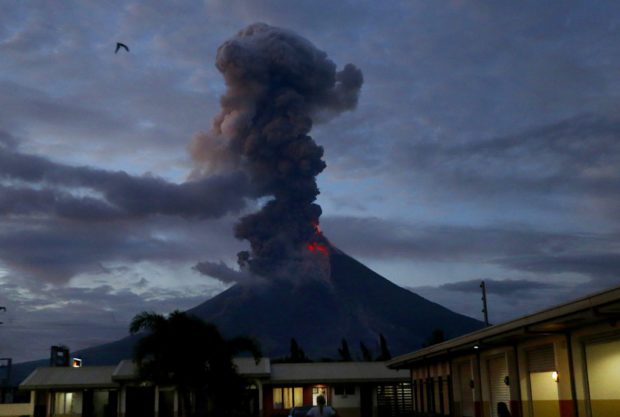
Mayon volcano spews red-hot lava in another eruption as seen from Legazpi City, Albay province, roughly 200 miles (340 kilometers) southeast of Manila, Philippines on Tuesday, January 23, 2018. Mayon has spewed fountains of red-hot lava and massive ash plumes anew in a dazzling but increasingly dangerous eruption that has sent thousands of villagers fleeing to evacuation centers. (AP Photo/Bullit Marquez)
The Philippine Institute of Volcanology and Seismology (Phivolcs) has recorded numerous volcanic activities at the peripheries of Mt. Mayon in Albay province, as the volcano continued to spew ashes and lava on Friday.
In its 8:00 a.m. bulletin, the Phivolcs specifically recorded a total of 15 volcanic earthquakes, 19 tremor events – seven of which correspond to the lava fountaining events, one episode of pyroclastic density current (PDC) generation from lava collapse, and numerous rock fall events around Mt. Mayon.
Between 6:11 a.m. on Thursday to 2:31 a.m. on Friday, Phivolcs chronicled a total of seven episodes of intense but sporadic lava fountaining from the summit crater that lasted between 26 and 57 minutes.
The lava fountains reached 150 to 500 meters high and generated ash plumes that reached 500 meters to 3 kilometers above the crater, Phivolcs said.
The events caused lava flows on the Mi-isi and Bonga Gullies, “sprayed near-vent lava spatter,” and resulted to incandescent rock fall on the summit area.
Phivolcs also observed PDCs on ravines heading towards Mi-isi, Lidong/Basud, and Buyuan channels as well as PDC runoffs on the Buyuan Channel that has exceeded 5 kilometers from the summit crater.
Lava from the summit crater continued to flow at the Mi-isi and Buyuan gullies at three km and one km distance, respectively, while sulfur dioxide gas emission was measured at an average of 1,916 tons per day on Thursday.
Phivolcs reminded residents in the area that Alert Level 4 remains in effect.
“The public is strongly advised to be vigilant and desist from entering the 8 kilometer-radius danger zone, and to be additionally vigilant against pyroclastic density currents, lahars and sediment-laden streamflows along channels draining the edifice,” it said.
“Civil aviation authorities must also advise pilots to avoid flying close to the volcano’s summit as ash from any sudden eruption can be hazardous to aircraft,” it added. /kga